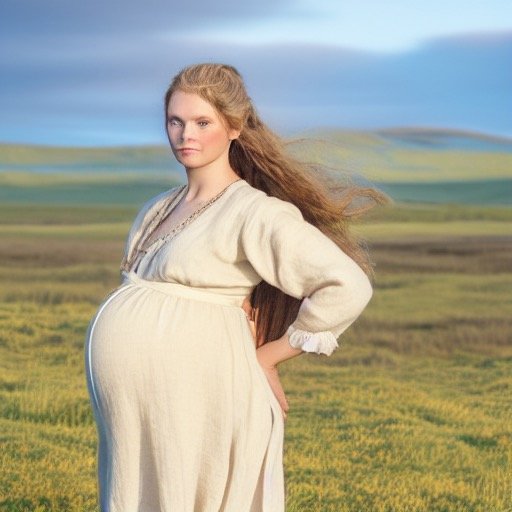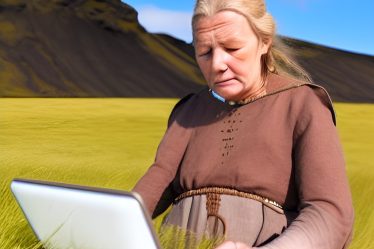
Take into account the period your character lives in
Naming practices have changed over the ages. For example, most Scandinavian countries have introduced surnames at some point, but Viking Age people only used what they called “kenningarnafn”, which is a patronym, matronym, sometimes a byname, and/or, very rarely, a place name to denominate one specific person. But there wasn’t a shared family surname nor did anyone change their name according to marital status. So you have to give your Viking Age characters a little more background: What are their parents‘ names, where do they come from, and if they have a very common name (basically anything beginning with Þor– and Þór-) they might need a characteristic to give them a byname and set them apart.
Family surnames were introduced to Scandinavian countries around the following times (source see below):
- Iceland: End of the 19th century. The creation of new surnames was stopped in 1925, so there exist only a couple of hundred different surnames today, and almost all people have patronyms.
- Sweden: Patronyms ending in –son or –dotter were used until the 16th century, when richer people started making their names posh by writing them in Latin (like Beronius for Björn). In the 17th century urban Swedes started using surnames that are common today, often taken from the landscape, ending for example in –lund, –berg, –gren, while rural Swedes stuck to patronyms. In the 19th century they converted patronyms to surnames, making for example Larsson a family name.
- Denmark: In 1526 surnames which from the 14th century onwards had been fashionable but were still uncommon became compulsory.
- Faroe Islands: In 1832 surnames which had been almost nonexistent became compulsory until 1992, when matronyms and patronyms (names ending in -son or -dóttir) became a legal option again.
- Norway: Patronyms ending in –son and –dotter were used until the 16th century when they started changing to –sen and –datter. Like in Sweden, the –sen names gradually became family surnames.
Not all modern Scandinavian names have an Old Norse provenance
Please don‘t pick a name for your 10th century Viking by opening a „Nordic Baby Names“ book. Nils is not a Viking name. One thousand years have brought on some changes, the most important of which, with regards to naming, was the arrival of Christianity. Feel free to name your character Símon but then he has to have Christian parents. Yes, there were Christian vikings.
Consider the region your character comes from
This one sounds pretty obvious, but it is so easy to make mistakes here. Names of people that spoke Old Norse are constructed according to the same principles throughout the whole language area, so that Freydís, Patrekr, or Garðarr are instantly recognizable as proper names by anyone, but their occurrence differs from region to region. Then there is the overlap with neighbouring cultures. It makes no sense to name a character from Gotland Kjallakr because the name has Gaelic roots, nor is it common to name a character from Norway Aðalfríðr even though the name follows all Old Norse conventions for a name.
Be aware of the way names are written in Latin vs. Old Norse
Rollo is not a Scandinavian name but a latinized Norman one. The Scandinavian name is Hrólfr. Sorry, you got it wrong, Vikings tv series. Ravenkel is a fine name for someone from Yorkshire, but if there was something written about him in Old Norse (at the time called the Danish Tongue) then his name was Hrafnkell. Osbern would be Ásbjörn, Sihere Siggeir, and Aghmund Ögmundr. There are many good names to be found in 👉 Domesday book, but they are all latinized. (Maybe someday I will write some more about the names in Domesday book. They are a lot of fun. William the Goat, Ralph the haunted, Walter the wild, Wulfwin the mead-keeper, Ralph Crooked Hands, …)
Beware of the U (and beware of translations in general)
Modern Icelanders, contrary to popular belief, have a surprisingly low tolerance towards their ancient language. Even though most will happily tell you they are super proud to be able to read one thousand year old literature, nobody except a handful of scholars does so! Old Norse literature that is published today in Iceland is heavily modernized.
Most importantly for our topic, people‘s names are written according to modern Icelandic grammar and spelling. Old Norse Óláfr becomes Ólafur, Álöf becomes Ólöf, and my absolute favourite Steinbjörn inn sterki ok inn stórhöggvi becomes Steinbjörn hinn sterki og hinn stórhöggvi. (Mind you, those Old Norse forms are already normalized in print. In the manuscripts the spelling can be quite free-style, and lots and lots of abbreviations are used because writing books was super expensive. The above name is Steinbiorn in 👉 AM 10 fol., the Book of Settlement, and some of the following glyphs used in the manuscript I can’t even type on my computer. Look for the name in the fourth-lowest line.) Often, translations are made from modernized editions, so you might come to think that „Eiríkur the Red“ really had a U in his name, but he didn‘t.
It‘s even worse with some English and most German translations, because it has been a translator‘s habit of germanicizing Old Norse names, changing Ketill to Ketil, Fraðmarr to Fradmar and Þórðr to Thord. In early cases this was due to typesetting limitations and did make sense at the time, but it has become some sort of a convention which you have to be aware of. 👉 We did so in the translation of the legendary sagas.
(If you want to see for yourself how old Norse was written and compare it to a normalized form, go to the catalogue of the 👉 Medieval Nordic Text Archive, Menota, and find a text that has both a facsimile, a diplomatic and a normalized edition, for example 👉 Íslendingabók AM 113 b.fol., open the text and make sure to check all the boxes showing the three levels Facs, Dipl, Norm.)
Don‘t get confused by bynames
Loðbrók is not a family surname. Bynames were not inherited as a rule, but there are exceptions. Skeggi of Miðfjörðr, Miðfjarðar-Skeggi, is the father of Eiðr Skeggjason, not Miðfjarðar-Skeggjason (but Molda-Gnúpr is the father of Iðunn Molda-Gnúpsdóttir. I think it’s because Molda-Gnúpr has a son also called Gnúpr.) Sometimes a byname can become a given name later. Lots of names ending in -i (Flóki, Hjalti…) came along that way.
Very, very rarely somebody has two names which are both given name,s and not a name followed by a byname. Konáll Þorsteinn is an example from Landnámabók.
Also, the son of Skeggi is not Skeggison:
Look out for the case of a name
Old Norse grammar is complex, and names, like adjectives and pronouns, have four cases. To form a patronym, you have to decline the father‘s name and use it in the genitive form. The other way around, don‘t just chop off the –son and use the rest as a name. The father‘s name in Harðarson is Hörðr, not Harðar.
There is no simple formula to gender change a name
You cannot stick an -r on Freydís to make a masculine name, nor can you convert an -r at the end into an -a to make a female version of Hrólfr. (There simply is no male form of Freydís and no female form of Hrólfr. It‘s not like Robert and Roberta. Helgi and Helga exist, but these names are derived from an adjective, and are exceptions.) Instead, you have to pick name components and combine them. Here are some examples:
- Components at the beginning of the name: Ás-, Arn-, Berg-, Geir-, Gunn-, Haf-, Her-, Ís-, Vé-
- Female components at the end of the name: -björg, -borg, -dís, -fríðr, -gerðr, -hildr, -laug, -veig, -vör, -þóra, -þrúðr
- Male components at the end of the name: -björn, -grímr, -kell, -laugr, -leifr, -mundr, -valdr, -varðr, -þórr
Not all of these combinations are interchangeable or would make for a beautiful name, and it is very hard to imagine Viking Age parents choosing Geirgrímr or Bergborg as baby names (and I have found no evidence that these names existed. Viking Age people were much more skilled in poetry than most modern people, so why would they choose something that sounded so bad?)
So, do you feel confident to pick a great Viking name now?
Post your questions in the comments!
This article was inspired by a 👉 Vísindavefur article on Scandinavian surnames (it’s in Icelandic). You can find more information on naming your Viking character (in English) at the 👉 Viking Answer Lady’s page on Old Norse names.


